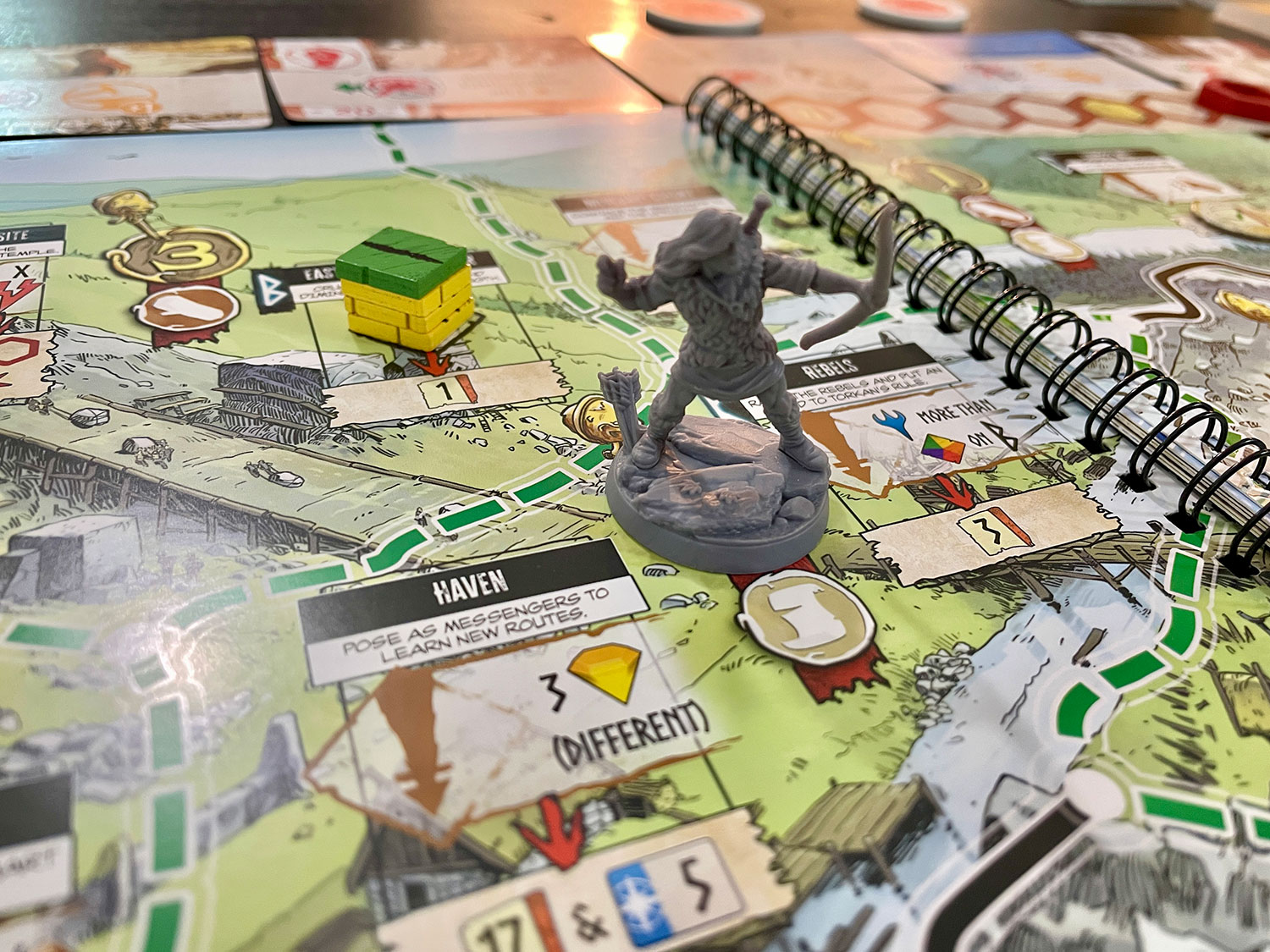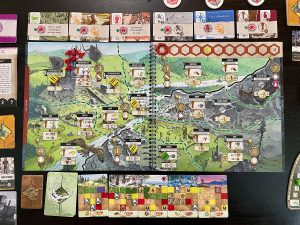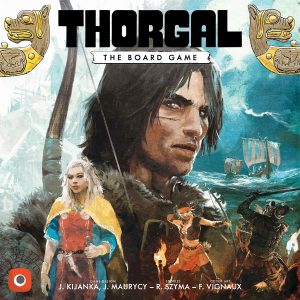 What do you get when you combine Norse mythology, interstellar travel, Atlantean legend, and fantasy and horror elements? None other than the son of Varth and Haynee, grandson of Xargos—Thorgal!—who has crash-landed on our planet and been adopted into the Viking world. This serialized comic started in the late 70s and still has stories being released in print form to this day.
What do you get when you combine Norse mythology, interstellar travel, Atlantean legend, and fantasy and horror elements? None other than the son of Varth and Haynee, grandson of Xargos—Thorgal!—who has crash-landed on our planet and been adopted into the Viking world. This serialized comic started in the late 70s and still has stories being released in print form to this day.
Portal Games has taken this internationally popular IP and turned it into a cooperative adventure game. It features seven standalone scenarios, several characters, and a central Book of Tales that provides flavor for each undertaking. Thorgal is designed by Joanna Kijanka, Jan Maurycy Święcicki, Rafał Szyma. It can be played from one to four in approximately 90-120 minutes.
Gameplay Overview:
Thorgal immerses players into a single scenario by asking them to read the introduction and setup from the Book of Tales, choose their characters, and take some time to review the atlas map for important information. Each scenario has its own win and loss conditions, specific event cards, and unique rules. Each scenario also has a preset grouping of action cards.
Many scenarios take place over eight to ten rounds and each round consists of four player actions. When playing solo, two characters must be played. The flow of a round consists of players taking an action disc and moving it to a new action card. Based on the location of other action discs, there may be powerful bonuses associated with placement.

Players attempt to gather resources, move throughout the atlas map discovering clues or gaining important artifacts, and begin to whittle away at the win condition. In the first scenario, for example, players must gather and assign specific resources OR battle against rising doom to stop a temple from being constructed against the will of the shackled masses.
The action types available to players remain the same between scenarios, though their specific power and placement are dictated by setup. Players can move between non-restricted locations, battle enemies, journey and gather for resources, assign resources to complete tasks, and craft items. Each action card features a bonus, and these can be upgraded to increase their effectiveness through certain tasks.
Characters have their own unique player board, which includes experience upgrades for combat and journeying, as well as a unique shape for wound placement. All three of these aspects of the game are dictated by polynomial pieces. Upon taking a journey action, players have access to specific shapes based on earned experience. These dictate how far they can reach for resources and new journey locations. Wounds taken are added to the wound area of the player board. If there is no space for a specific shape, the player dies, and the scenario is lost.

In combat, characters have a specific dice pool based on their experience level. These dice feature polynomial shapes that are utilized to cover up hearts on enemy cards. These enemy cards also feature experience and resources, as well as light and heavy wounds, that are all gained when covered. If all hearts are covered by the shapes, then the enemy is defeated.
After all actions are taken in a round, players must resolve an event card as well as draw a new one for the next round. Event cards feature icons that trigger scenario-specific penalties to ramp up the danger. There are two stacks of event cards and which one is drawn based on specifics for the scenario.
There are several other elements at play in the game. There is a threat resource, ongoing wounds when unable to complete certain actions, one-time use item cards, as well as goods cards that can be gained via the journey action. All of this, combined with the variability of the seven included scenarios, provides a lot to unpack and explore over time.

Game Experience:
There is quite a lot to like about Thorgal’s systems and many feel fresh. The action card system, with its placement bonuses and potential upgrades, provides a lot of strategy. These bonuses come into play often as players try to assign large numbers of goods to locations to complete them efficiently, as well as using the gather action bonuses to gain many resources. In combat, placement may allow for rerolls and criticals. Even movement and journeying can be boosted by placement.
The polynomial tile system is also excellent. These are used in three different ways and as such they feel fully integrated into everything you do. Yes, it is strange to have this fantasy narrative adventure throw these into the mix, but it doesn’t take long for them to feel right at home within your actions. Each character’s player board also enhances these tiles as they have their own asymmetric upgrades and wound areas.

The illustration is excellent as well and helps to immerse you in play. I do wish that Portal would’ve chosen to do acrylic standees to enhance the art further, rather than the dull gray minis which feel out of place amongst all the bright color, but the setting still stands out. The Book of Tales, which includes each scenario’s flavor text, does a great job of enhancing each session, but it doesn’t do enough to give each scenario weight.
I see why this was designed as a scenario-based system. Tracking character changes over time and having an ongoing experience system would add weight. But based on the source material, I do hope that they can find a way to develop a short campaign that creates meaningful decisions between scenarios and adds depth to actions. As it stands now, this feels like a standalone puzzle system. It works but does leave a little of the theme off the table.

Thorgal’s production, for the most part, is also excellent. The rulebook is very high quality, the tiles and cards all feel great, and the Book of Tales is well-designed. There are certain shortfalls that I want to bring to light though. First, the atlas map features a very significant amount of information with icons and text, and it is quite small on larger tables. It requires a lot of pre-game review to determine where everything is located, how movement may proceed, where to focus, etc. It’s nice to have a small footprint. Here, it tasks players with enhancing it on their own.
Thorgal’s production also has not considered colorblind accessibility. It uses many red/green combinations that make distinction hard for some users. I also received the promo box which features frosted dice, and these are hard to distinguish at times. Yes, there are icons in other areas that do help clarify, especially on enemy tokens, but I did find accessibility an ongoing issue.
Final Thoughts:
Thorgal is a lot of fun. I can see this as the beginning of an ongoing and enhanced product over time from Portal. Add in more features, update production issues, and provide more Book of Tales and mini-campaigns. I would stick around for that ride. As of now, it has enough variability within the box to be a worthwhile investment. It does play best as a solo or two-player experience. And while it doesn’t overstay its welcome, it does have some punishing moments that may make some scenarios difficult early on. But such is the way of the star-fallen warrior Thorgal. A new landscape to discover, systems to experience, and tales to be told. This may be exactly the type of cooperative adventure you’ve been seeking.
Final Score: 3.5 stars – The origin arc of a system that requires a little more investment to become a classic.
 Hits:
Hits:
• Innovative polyomino use
• Action selection upgrades
• Excellent illustration
• Quality rulebook
Misses:
• Standalone vs. campaign
• Initial scenario overload
• Atlas map size
• Colorblind issues
Source: Board Game Quest





